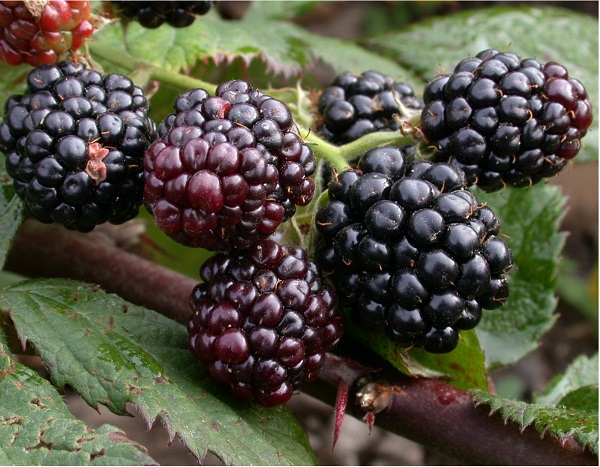The spread in the amateur gardens of a remarkable berry bush, blackberries, is restrained, in part, by the presence of numerous spines on its shoots. Therefore, the appearance of beshipless varieties in the 1960s, greatly facilitated the cultivation of this crop.
Table of contents
Description of the blackberry variety Tornfri
Tornfrey, one of the first varieties of blackberry with a complete lack of thorns, was bred in 1966 by the breeder of the state of Maryland in the eastern part of the USA - Dr. Scott.It belongs to the group of rosyanik, forms a bush with long semi-creeping hard shoots. Faceted shoots at the base, up to 3 centimeters thick, reach 4-6 meters. Dark green - at the beginning, by the end of the season they become bluish. The leaves are complex, consist of 3-5 leaves.
The bush is beautiful during flowering, when it is covered with rather large pink flowers with a diameter of up to 3–3.5 cm. Thus, in Central Russia, the beginning of flowering occurs in the second half of June.
Characteristic berries
Now let's talk about the characteristics of the berries. Productivity varieties high. Up to 22 kg of fragrant berries are picked from individual adult bushes. Dark purple, almost black, conical in shape, with a shiny skin, they weigh up to 5-7 grams. The ripening of the berries is not simultaneous and the fruiting period can be stretched to a month and a half.
The taste of the berries changes as they ripen: from sour to sour-sweet and fresh-sweet when over-ripening.Berry brush, sometimes numbering up to 30-60 berries, hangs under its own weight to the ground.
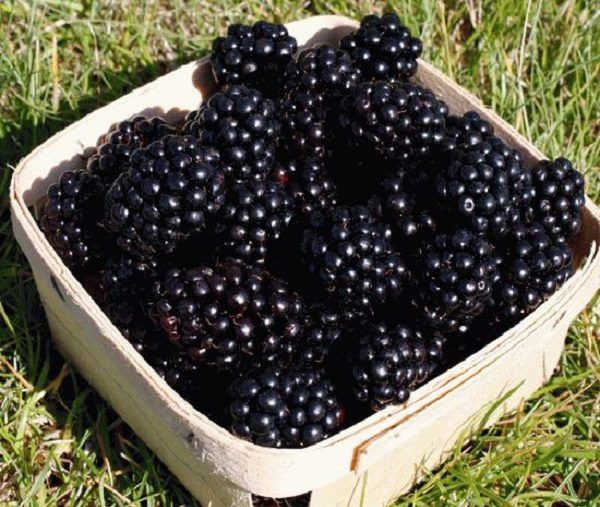
The advantages and disadvantages of the variety
Among the advantages of the variety, in addition to the lack of thorns:
- unpretentiousness;
- super yield;
- transportability;
- resistance to diseases and damage by pests allows to exclude treatment with chemicals;
- elegant appearance, both at the time of flowering and during fruiting.
But, for all its merits, the Tornfrey variety has one major drawback. It is quite difficult for an inexperienced gardener to catch the moment of the desired ripeness of the berry, when it is still dense, but already has a pleasant sweet taste with a slight sourness. Immature berry - sour, overripe - fresh-sweet and very soft. The fact is that at different moments of its ripeness the berry looks the same. Unobtrusive differences are not striking, so some experience is needed when harvesting.
Winter hardiness is below average, the variety requires mandatory shelter for the winter. Without it, cultivation is possible only in the southern regions. There you have to take care of some shading of the plant, as it may suffer from sunburn.This variety is not suitable for areas of North-West Russia.
But, in principle, it all depends on the microclimate at a particular site.
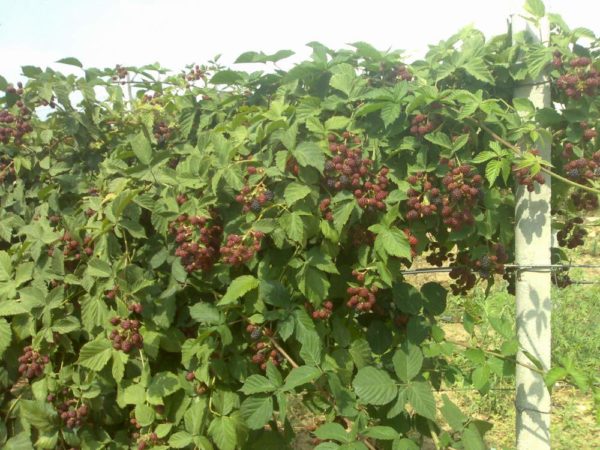
Planting seedlings and care in autumn
In comparison with other varieties, frost resistance is average, Tornfrey can withstand temperatures down to -18 degrees. Thaws and a strong spring wind cause the desiccation of shoots, so do not rush to remove the winter shelter.
The agrotechnology of growing blackberries is in many ways similar to that of raspberry. Blackberries grow well on most soils, with the exception of sandy. But, fertile loams are best suited to her. The best planting time for seedlings with an open root system - spring grown in containers can be planted all season.
Fill the trench and, if necessary, plug it with a full complex fertilizer. Acid soils lime. During the winter, the earth will settle and be ready for planting.
Plants are placed apart at a distance depending on the variety and the subsequent method of its formation. For a powerful blackberry, which is a variety of Tornfri, one-sided formation system is particularly well suited. This method of garter is simple and consists in the fact that the annual shoots are directed in one direction, and last year in the other. Therefore, the distance between the plants should be about 3 - 4.5 meters.
After planting, the stems are pruned, leaving shoots 25 cm high, and the root neck should be 2-3 cm below the soil level. The earth around the plant is mulched with peat, sawdust, and shredded branches to avoid loss of moisture and the formation of a soil crust.
You may also be interested in the following blackberry articles:
Growing and breeding conditions
Thornfrey bushes are grown on a trellis, with several rows of stretched wire between the supports. Its height usually does not exceed 1.8 meters, so that it is convenient to place long lashes.
In the first year, emerging shoots are tied closer to the left stake.The right side of the support remains free.
Next summer, new shoots will appear at the base of the bush, which are tied closer to the right stake. Blackberry fruits on the side branches of the growth of last year.
Caring for blackberry plants is shallow loosening, watering and dressing. It is especially important to regularly water the berry bushes during the first time after planting, as well as during the flowering and formation of the ovary. An adult plant can do without watering, thanks to a well-developed root system. But you will not have to rely on a big crop. By the end of summer - the beginning of autumn, after harvesting, watering is reduced, so that the shoots have time to woody.
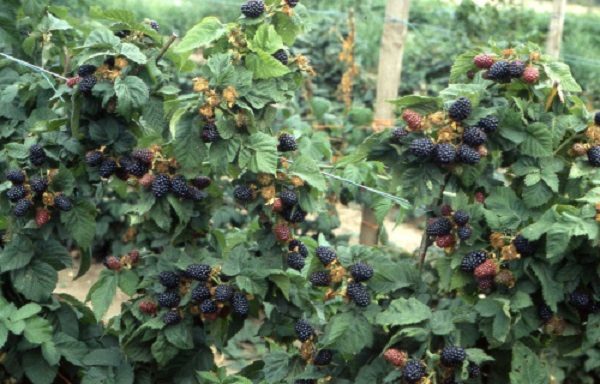
Before the onset of frost make water-charging irrigation and remove the scourge from the supports. Since for Thornfri the temperatures below -18 degrees will be critical, it is desirable to cover it even before the snow falls. Thornfrey shelter is not easy.Undemanding thick shoots hardly fit on the ground. You can make a short nip of shoots during the period of their formation. In order to get more flexible, thin side shoots, which will be easier to cope with, they practice a short nip of the forming lashes.
Some gardeners dig up a blackberry bush on one side and lay it to the side. From above cover spunbond or lutrasil. You can also add cardboard, dry foliage, spruce branches. Fallen snow will provide additional protection. It is important to cover the base of the bush, the so-called "head". This part is often below the level of snow cover.
Reproduction Thornfrey does not cause any difficulties. Like any variety of rosyanik, it is well rooted tops of shoots. To obtain a large number of cuttings, you can use the method of green cutting. So to propagate this shrub is not so difficult.
Diseases and pests
Proper planting and compliance with all the rules of care contribute to the fact that blackberries are rarely exposed to diseases and attack by pests. If both blackberry and raspberry grow on the same plot, it is advisable to plant them by 100 meters apart. Raspberries are carriers of a hidden form of green mosaic, which is dangerous for blackberries.
Tornfrey is resistant to common diseases such as anthracnose, rust and stem cancer.. But, when signs of disease appear, it is better to sacrifice a part of the crop, without resorting to the use of pesticides, replacing them with biofungicides.
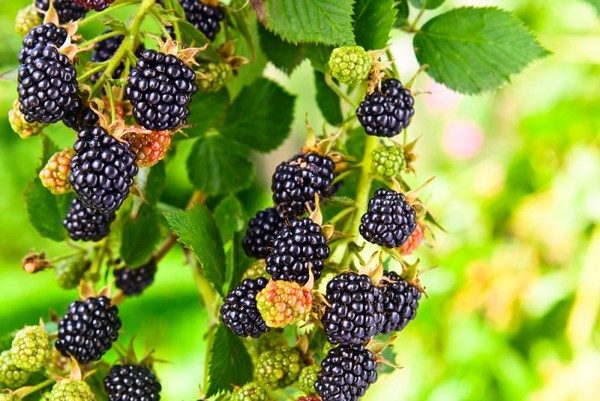
With the defeat of blackberry gall mites, the berries do not ripen, partially or completely remaining red. A very small pest winters on a bush, moving in the spring to flowers, then to fruits. Therefore, in the fall, be sure to cut and destroy old stems. After this, the bushes are processed by strong infusions of garlic or pyrethrum. In the spring processing is repeated.
Since the advent of Thornfrey half a century has passed. There are other varieties of besshipnaya blackberry, which surpass it in quality berries.At the same time, due to the yield and used agricultural technology, it remains one of the leading varieties for commercial cultivation. And to “settle” him on his plot or not, each gardener decides for himself.
